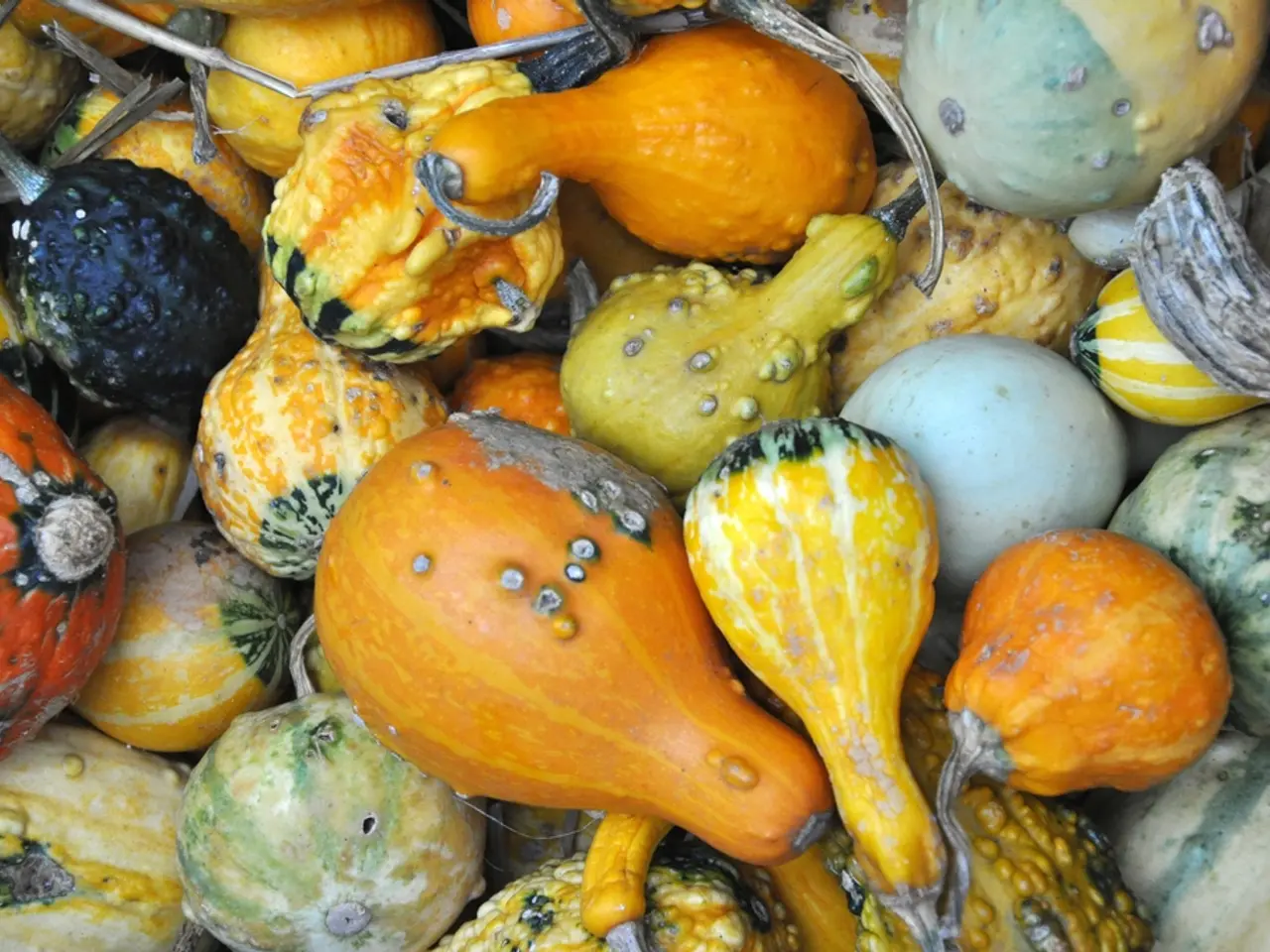Agricultural Issues Stemming from Weather Conditions in the Vegetable Patch
In a vegetable garden, maintaining a healthy and productive crop can sometimes be challenging due to various non-infectious, weather-related problems. This article aims to provide gardeners with practical tips to manage and prevent issues such as Blossom-End Rot, Blossom Drop, Poorly Filled Ears, Bitter Fruit, Sunscald, Split Cabbage Head, Fruit Cracks, and Misshapen, Underdeveloped Fruit.
Maintain Uniform Soil Moisture
Many disorders, like Blossom-End Rot (brown/black spots on fruit from calcium deficiency worsened by fluctuating moisture), arise when soil moisture is inconsistent. To keep moisture steady, use mulching and regular watering during dry spells. Mulching with a 2-3 inch layer of organic material like straw, bark chips, or dried leaves, can protect the soil surface from heavy rain impacts, reduce water evaporation during dry periods, suppress weeds, and stabilise soil temperature.
Mulching
Mulching also reduces soil erosion and helps prevent physiological disorders caused by erratic wet/dry cycles. By maintaining uniform soil moisture, not only does it improve calcium uptake, but it also helps control Blossom-End Rot and other disorders.
Avoid Excessive Nitrogen Fertilization
Over-fertilizing with nitrogen can aggravate Blossom-End Rot and similar physiological disorders by promoting excessive leafy growth at the expense of calcium transport to fruits.
Elevate Garden Beds
Raised beds (6-12 inches high) prevent waterlogging by allowing excess rainwater to drain away, reducing root damage and stress that contribute to fruit disorders like poorly filled ears or split heads.
Provide Shading and Protection from Extreme Heat and Sun
Sunscald and heat damage cause blemishes and poor fruit development. Shade cloth (30-70% shade) or planting taller crops can shield sensitive vegetables, also helping preserve moisture in soil.
Plant Resistant and Suitable Varieties
Choose vegetable varieties that tolerate your local weather conditions, such as heat- or moisture-tolerant types, to reduce stress that causes bitter fruit, fruit cracks, and misshapen fruit.
Consistent Monitoring and Timely Intervention
Regularly inspect plants for signs of physiological disorders or stress, prune damaged foliage, and support plants to prevent physical damage from wind or hail.
By applying these combined strategies—soil moisture management through mulching and watering, raised beds for drainage, nutritional balance, shading, and variety selection—gardeners can help minimise the occurrence of these weather-related but non-infectious disorders and promote healthier, more productive vegetable gardens.
Specific Disorders and Solutions
Blossom-End Rot
Blossom-End Rot affects tomato, pepper, and summer squash. This physiological disorder is caused by a lack of calcium in the developing fruit due to wide fluctuations in soil moisture levels. To manage Blossom-End Rot, maintain uniform soil moisture levels by mulching and watering plants during dry weather, and avoid over-fertilizing with nitrogen.
Sunscald
Sunscald affects tomato and pepper crops, appearing as shiny white or yellow areas on the sides of the fruit exposed to the sun, which later dry out and collapse. Growing tomatoes in wire cages provides good foliage protection and can help control sunscald.
Poorly Filled Ears
Poorly Filled Ears in sweet corn and popcorn are caused by inadequate pollination due to hot, dry winds and dry soil conditions during pollination. To control this, plant sweet corn and popcorn in blocks of 4 or more short rows to ensure pollination, and water the plants during pollination if the soil is dry.
Fruit Cracks
Cracking can be reduced by providing uniform supplies of moisture to the plants and planting crack-resistant varieties like 'Jetstar'.
Bitter Fruit
Bitter fruit in cucumbers develops when plants are subjected to stressful growing conditions, including high temperatures, drought, and disease problems. Much of the bitterness in cucumbers can be removed by cutting off the stem end and peeling the remaining portion of the fruit.
Split Cabbage Head
Split cabbage head occurs when mature cabbage plants split, caused by a build-up of water pressure. Splitting may be prevented by pulling the mature plant upward and gently twisting the plant to break some of the roots.
Blossom Drop
Blossom Drop occurs in tomato, pepper, and snap beans due to extremes in temperature and dry conditions, resulting in poor pollination and causing flowers to drop without setting fruit. Watering plants deeply once a week can help control Blossom Drop.
By understanding these common garden disorders and implementing the appropriate solutions, gardeners can enjoy a bountiful and healthy harvest. Happy gardening!
[1] University of California Agriculture and Natural Resources. (2021). Managing blossom-end rot in tomatoes, peppers, and other crops. [online] Available at: https://ucanr.edu/sites/VegetableCrops/files/301432.pdf
[2] Iowa State University Extension and Outreach. (2021). Blossom-end rot in tomatoes. [online] Available at: https://www.extension.iastate.edu/vegetable/blossom-end-rot-tomatoes
[3] University of Missouri Extension. (2021). Blossom end rot. [online] Available at: https://extension2.missouri.edu/g431
[4] Purdue University Extension. (2021). Sunscald of tomatoes. [online] Available at: https://extension.purdue.edu/extmedia/BP/BP-64-W.pdf
[5] University of Illinois Extension. (2021). Blossom end rot. [online] Available at: https://web.extension.illinois.edu/cfivt/blossom-end-rot/
- To prevent Blossom-End Rot, which can cause brown or black spots on fruit due to calcium deficiency worsened by inconsistent moisture, maintain uniform soil moisture through mulching and regular watering during dry periods.
- Mulching also helps reduce soil erosion, suppress weeds, stabilize soil temperature, and prevent physiological disorders caused by erratic wet/dry cycles.
- Over-fertilizing with nitrogen can worsen Blossom-End Rot and similar disorders by promoting excessive leafy growth at the expense of calcium transport to fruits.
- Elevating garden beds to 6-12 inches high can help prevent waterlogging, reducing root damage and stress that contribute to fruit disorders like poorly filled ears or split heads.




